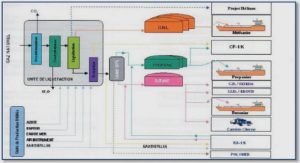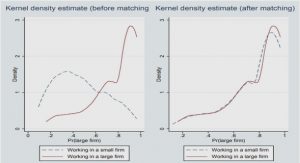Get Complete Project Material File(s) Now! »
The selection of cytotoxicity assay
A hormetic effect was evident in the resazurin assay when cells were exposed to the methanol extract of T. elegans, where metabolic activity increased at lower concentrations. This could indicate an adaptive, metabolic change within the cells to counteract the phytotoxicity of the crude extracts. To assess whether the extracts were directly converting resazurin to resorufin, cell-free assays were performed for further elucidation. Although a slight dose-dependent increase in fluorescent activity was found, this was not considered significant enough to explain the interference noted.
As cells were necessary for this interaction to occur, it can be inferred that an upregulation of metabolic enzyme activity is needed for the conversion of resazurin.
No correlation between the interaction and solvent type was present.
The interaction observed appeared to be specific towards the metabolic conversion of resazurin, as MTT was unaffected. As many mitochondrial and cytosolic enzymes are involved in the metabolic conversion,191 it is possible that any of them may have been influenced without allowing for an overlap with MTT conversion. In support of the specific effect that may take place, glycolysis inhibitors have been shown to influence MTT conversion without altering resazurin.192 Thus some substrate-specificity may be involved in the conversion, even though similar enzyme systems are involved.
Spontaneous conversion of resorufin to non-fluorescent dihydroresorufin does occur, but only after a prolonged incubation period,191 and thus this was not considered a likely possibility taking into consideration the time-course of the experiment. Although few compounds have been reported to alter resazurin conversion, many have been implicated in interference with MTT, such as dicoumarol,193 epigallocatechin gallate,194 various antioxidants, phytoestrogens and different plant extracts.195 To the best of the authors knowledge, no literature was present describing phytochemical interference with resazurin, though it has been reported for some redox cycling compounds (that increase ROS production)196 and nanoparticles197. As only the HepG2 cell line was studied, it is possible that a different scenario may be apparent in other cell lines.
The SRB and resazurin assays proved to be less variable than the MTT and neutral red assays. Cytotoxicity was underestimated for the resazurin assay, while the MTT and neutral red offered higher sensitivity for four of the extracts. This could be due to potential selective toxicity against mitochondria or lysosomes, respectively, and brings to light the importance of multiple assessment criteria. As SRB proved to be reproducible and offered high sensitivity, which is also supported by literature,188 it was chosen for the remainder of cytotoxicity testing.
Effects of crude extracts on the HepG2 and Caco-2 cell lines
Preliminary cytotoxicity screening using the HepG2 and Caco-2 cell lines was performed to determine which plants would be selected to undergo further hepatotoxic evaluation, and to account for possible confounding factors in future drug-herb interaction assays. Three groups of plants were subsequently selected: i) those presenting with a mixture of high hepatotoxic potential (A. oppositifolia, S. aculeastrum and T. elegans), ii) moderate cytotoxicity (B. disticha) and iii) those presenting with low cytotoxic potential and beneficial health effects as supported by literature (M. oleifera, T. sericea and Z. mucronata). These three groups were selected to provide toxicological information on the spectrum of toxicity. These results will be discussed separately in Chapter 4.
Phytotoxicology with regards to hepatic and intestinal cytotoxicity is poorly described in literature, and as such the results obtained aim to increase the toxicological knowledge of the plants investigated. It is important to note that the cell lines used in this study are of cancerous origin, and thus may present with an altered response towards cytotoxins, though they do provide a model for further assessment. In general cytotoxicity was more prominent in the Caco-2 cell line, indicating a potential selective cytotoxicity for intestinal cells, rather than for those of hepatic origin. As an area of main absorption for oral administered drugs, this may incur gastrointestinal irregularities and toxicity. A discussion on the cytotoxicity will be approached from the perspective of the different plant families. Cytotoxicity data that could be obtained for the plants discussed in this chapter have been summarised in Table 9.
Amaryllidaceae
The hot water extract of C. bulbispermum displayed little cytotoxicity in the HepG2 cell line (42.67% at 100 μg/mL), while its methanol counterpart was more active (IC50 = 67.24 μg/mL). The Caco-2 cell line (hot water IC50 = 64.25 μg/mL; methanol = 31.20 μg/mL) was more susceptible to cytotoxic effects. It is apparent that moderate cytotoxicity is induced by organic extracts of C. bulbispermum.198 The methanol extract of the bulbs induced moderate cytotoxicity in the SH-SY5Y neuroblastoma cell line (Table 9).198 The ethyl acetate extract of the bulbs displayed no cytotoxic potential,198 while the ethyl acetate extract of the roots displayed prominent cytotoxicity (Table 9).199 Ether and butanol fractions of pH-adjusted extracts of the flowering and nonflowering bulbs, respectively, induced moderate toxicity in the brine shrimp assay (Table 9).92 While the hot water extract of S. puniceus was not highly cytotoxic in the HepG2 and Caco-2 cell lines (18.76% and 11.34% cell death at 100 μg/mL, respectively), the methanol extract induced similar cytotoxicity in both cell lines (IC50 = ~30 μg/mL). This may imply a non-specific mechanism of cytotoxicity. The low cytotoxic potential of the hot water extract (Appendix IV), and greater cytotoxicity of the organic extracts has been described in literature198 (Appendix IV).
Chapter 1: Introduction to herbal remedy usage, and its relevance in hepatotoxicity and drug-herb interactions
1.1. Literature review
1.2. Aim of the study
1.3. Objectives
Chapter 2: Extraction and crude phytochemical screening of herbal remedies
2.1. Literature review
2.2. Materials and Methods
2.3. Results
2.4. Discussion
2.5. Conclusion
Chapter 3: Preliminary phytotoxicological assessment of herbal remedies in the HepG2 hepatocarcinoma and Caco-2 colon carcinoma cell lines
3.1. Literature review
3.2. Materials and Methods
3.3. Results
3.4. Discussion
3.5. Conclusion
Chapter 4: In vitro assessment of hepatotoxic potential of herbal remedies
4.1. Literature review
4.2. Materials and Methods
4.3. Results
4.4. Discussion
4.5. Conclusion
Chapter 5: In vitro effect of herbal remedies on absorption and metabolism
5.1. Literature review
5.2. Materials and Methods
5.3. Results
5.4. Discussion
5.5. Conclusion
Chapter 6: Conclusion
6.1. Concluding remarks
6.2. Executive summary
6.3. Limitations of the study and recommendations
References






